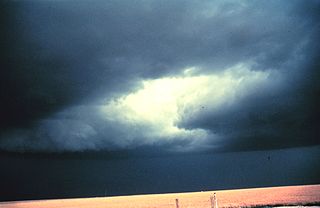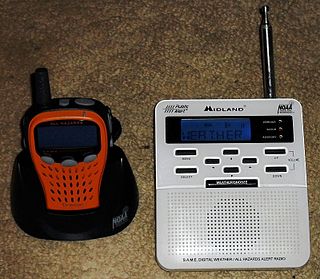
The Emergency Broadcast System (EBS), sometimes called the Emergency Action Notification System (EANS), was an emergency warning system used in the United States. It was the most commonly used, along with the Emergency Override system. It replaced the previous CONELRAD system and was used from 1963 to 1997, at which point it was replaced by the Emergency Alert System.

CONELRAD was a method of emergency broadcasting to the public of the United States in the event of enemy attack during the Cold War. It was intended to allow continuous broadcast of civil defense information to the public using radio stations, while rapidly switching the transmitter stations to make the broadcasts unsuitable for Soviet bombers that might attempt to home in on the signals.

The Emergency Alert System (EAS) is a national warning system in the United States designed to allow authorized officials to broadcast emergency alerts and warning messages to the public via cable, satellite and broadcast television and AM, FM and satellite radio. Informally, Emergency Alert System is sometimes conflated with its mobile phone counterpart Wireless Emergency Alerts (WEA), a different but related system. However, both the EAS and WEA, among other systems, are coordinated under the Integrated Public Alert and Warning System (IPAWS). The EAS, and more broadly IPAWS, allows federal, state, and local authorities to efficiently broadcast emergency alert and warning messages across multiple channels. The EAS became operational on January 1, 1997, after being approved by the Federal Communications Commission (FCC) in November 1994, replacing the Emergency Broadcast System (EBS), and largely supplanted Local Access Alert systems, though Local Access Alert systems are still used from time to time. Its main improvement over the EBS, and perhaps its most distinctive feature, is its application of a digitally encoded audio signal known as Specific Area Message Encoding (SAME), which is responsible for the characteristic "screeching" or "chirping" sounds at the start and end of each message. The first signal is the "header" which encodes, among other information, the alert type and locations, or the specific area that should receive the message. The last short burst marks the end-of-message. These signals are read by specialized encoder-decoder equipment. This design allows for automated station-to-station relay of alerts to only the area the alert was intended for.

A tornado warning is a public warning that is issued by weather forecasting agencies to an area in the direct path of a tornado, or a severe thunderstorm capable of producing one, and advises individuals in that area to take cover. Modern weather surveillance technology such as Doppler weather radar can detect rotation in a thunderstorm, allowing for early warning before a tornado develops. They are also commonly issued based on reported visual sighting of a tornado, funnel cloud, or wall cloud, typically from weather spotters or the public, but also law enforcement or local emergency management. When radar is unavailable or insufficient, such ground truth is crucial. In particular, a tornado can develop in a gap of radar coverage, of which there are several known in the United States.

A severe thunderstorm warning is a type of public warning for severe weather that is issued by weather forecasting agencies worldwide when one or more severe thunderstorms have been detected by Doppler weather radar, observed by weather spotters, or reported by an emergency management agency, law enforcement, or the general public. Unlike a watch, a warning is issued to areas in the direct path of active severe thunderstorms, that are expecting a direct impact typically within an hour. Severe thunderstorms can cause property damage and injury due to large hail, high winds, and flooding due to torrential rainfall. The exact criteria to issue a warning varies from country to country.
Specific Area Message Encoding (SAME) is a protocol used for framing and classification of broadcasting emergency warning messages. It was developed by the United States National Weather Service for use on its NOAA Weather Radio (NWR) network, and was later adopted by the Federal Communications Commission for the Emergency Alert System, then subsequently by Environment Canada for use on its Weatheradio Canada service. It is also used to set off receivers in Mexico City and surrounding areas as part of the Mexican Seismic Alert System (SASMEX).

NOAA Weather Radio (NWR), also known as NOAA Weather Radio All Hazards, is an automated 24-hour network of VHF FM weather radio stations in the United States that broadcast weather information directly from a nearby National Weather Service office. The routine programming cycle includes local or regional weather forecasts, synopsis, climate summaries or zone/lake/coastal waters forecasts. During severe conditions the cycle is shortened into: hazardous weather outlooks, short-term forecasts, special weather statements or tropical weather summaries. It occasionally broadcasts other non-weather related events such as national security statements, natural disaster information, environmental and public safety statements, civil emergencies, fires, evacuation orders, and other hazards sourced from the Federal Communications Commission's (FCC) Emergency Alert System. NOAA Weather Radio uses automated broadcast technology that allows for the recycling of segments featured in one broadcast cycle into another and more regular updating of segments to each of the transmitters. It also speeds up the warning transmitting process.

An emergency population warning is a method where by local, regional, or national authorities can contact members of the public to warn them of an impending emergency. These warnings may be necessary for a number of reasons, including:

A weather radio is a specialized radio receiver that is designed to receive a public broadcast service, typically from government-owned radio stations, dedicated to broadcasting weather forecasts and reports on a continual basis, with the routine weather reports being interrupted by emergency weather reports whenever needed. Weather radios are typically equipped with a standby alerting function—if the radio is muted or tuned to another band and a severe weather bulletin is transmitted, it can automatically sound an alarm and/or switch to a pre-tuned weather channel for emergency weather information. Weather radio services may also occasionally broadcast non-weather-related emergency information, such as in the event of a natural disaster, a child abduction alert, or a terrorist attack.

A flash flood warning is a severe weather warning product of the National Weather Service that is issued by national weather forecasting agencies throughout the world to alert the public that a flash flood is imminent or occurring in the warned area. A flash flood is a sudden, violent flood after a heavy rain, or occasionally after a dam break. Rainfall intensity and duration, topography, soil conditions, and ground cover contribute to flash flooding.
A fire warning is a warning issued through the Emergency Alert System (EAS) in the United States by civil authorities to inform the public of major, uncontrolled fires threatening populated areas and/or major roadways. A red flag warning will generally precede any fire activity by at least one to two days. A fire warning will generally include information on the location and movement of the fire, evacuation instructions, and shelter locations.
A flood warning is closely linked to the task of flood forecasting. The distinction between the two is that the outcome of flood forecasting is a set of forecast time-profiles of channel flows or river levels at various locations, while "flood warning" is the task of making use of these forecasts to make decisions about whether warnings of floods should be issued to the general public or whether previous warnings should be rescinded or retracted.

Wireless Emergency Alerts (WEA), formerly known as the Commercial Mobile Alert System (CMAS), and prior to that as the Personal Localized Alerting Network (PLAN), is an alerting network in the United States designed to disseminate emergency alerts to mobile devices such as cell phones and pagers. Organizations are able to disseminate and coordinate emergency alerts and warning messages through WEA and other public systems by means of the Integrated Public Alert and Warning System.

A National Emergency Message, formerly known until 2022 as an Emergency Action Notification, is the national activation of the Emergency Alert System (EAS) used to alert the residents of the United States of a national or global emergency such as a nuclear war or any other mass casualty situation. This alert can only be activated by the president of the United States or a designated representative thereof, such as the vice president. The Emergency Broadcast System (EBS) also carried the Emergency Action Notification. Except for the 2011 national test, which utilized the Emergency Action Notification alert type, no president has ever issued a National Emergency Message.
A river flood warning is issued by the National Weather Service of the United States when forecast points with formal river gaging sites and established flood stages along rivers, where flooding has already been forecast, is imminent or occurring. The National Weather Service defines river flooding as "the inundation of normally dry areas as a result of increased water levels in an established water course."
Evacuation immediate is a warning issued through the Emergency Alert System (EAS) in the United States to notify the public of a mandatory evacuation due to a wildfire, approaching hurricane, or an imminent explosion due to a gas leak. It is typically issued by a local or state authority and is relayed by the National Weather Service. The warning can replace a Civil Emergency Message, Fire Warning, or other warnings when required.
A civil emergency message is a warning issued through the Emergency Alert System (EAS) in the United States to warn the public of a significant in-progress or imminent threat or danger to public safety. It is typically issued by a local or state authority and is relayed by the National Weather Service. The warning is a higher priority than a local area emergency (LAE), but it's less specific than a civil danger warning (CDW). For example, the warning could be used to describe an alert issued by the National Terrorism Advisory System.
A civil danger warning is a warning issued through the Emergency Alert System (EAS) in the United States to warn the public of an event that presents danger to a significant civilian population. It is typically issued by a local or state authority and is relayed by the National Weather Service. The warning usually mentions a specific hazard such as contaminated water supply, active shooting, unexpected weather alert such as causing roads to be extremely dangerous, major accident, or an imminent or in-progress military or terrorist attack. It may also provide instructions for protective action such as to evacuate, shelter-in-place, boil water or seek medical treatment. The warning has a higher priority than a local area emergency (LAE), as well as a Civil Emergency Message (CEM).
A dust storm warning is issued by the National Weather Service in the United States when blowing dust is expected to frequently reduce visibility to 1⁄4 mile (400 m) or less, generally with winds of 25 miles per hour (40 km/h) or more.

On February 11, 2013, the Emergency Alert System of five different television stations across the U.S. states of Montana, Michigan, Wisconsin, and New Mexico were hijacked, interrupting each television broadcast with a Local area emergency message warning viewers of a zombie apocalypse. The message was subsequently declared as a hoax by local authorities and was reported to be a result of hackers gaining access to the Emergency Alert System equipment of various television stations.












